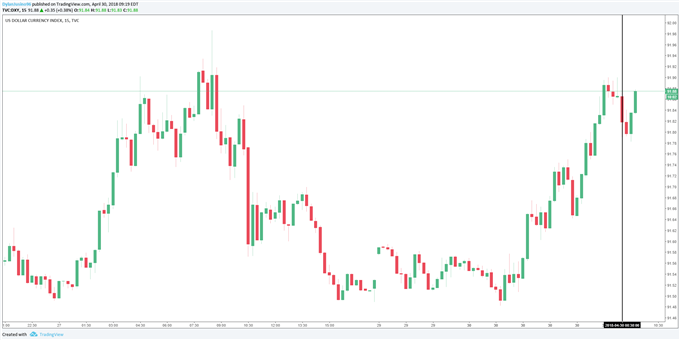
PCE Discussion Points:
– The Personal Consumption Expenditure came in line in March; notably, Core PCErose by 1.9% YoY
– Personal income was in line as well at 0.4%, spending rose by 0.3%
– Fed maintains inflation outlook despite missing target in March, likely to leave rates unchanged this week
– See the DailyFX Economic Calendar for upcoming economic data and for a schedule of live coverage see the DailyFX Webinar Calendar.
US Inflation Slightly Below 2%
Today’s Personal Income and Outlays report revealed marks the last trading day of the month and quarter for US markets. The Fed’s preferred inflation gauge, the Personal Consumption Expenditure Index (PCE), increased by $61.7 billion, or 0.4% in March. Disposable income, which is income rose slightly less at $39.8 billion, or 0.3% last month. And similarly, personal income rose by 47.8% billion which also equates to 0.3%. Although, on a “real” basis, which adjusts for inflation, PCE increased by 0.2% and disposable income matched that figure also coming in at 0.2%. BEA reported that income changes in March primarily reflected increases in wages and salaries, social security benefits, and dividend income. In terms of spending, the big-ticket items that were purchased last month were mainly recreational good and vehicles. Here’s a table reflecting recent income and spending outlays:

Source: BEA: Personal Income and Outlays, March 2018
Key Terms to Understand
The PCE Index is the value of the goods and services purchased by, or on thebehalf of, “persons” who reside in the United States. The Bureau of Economic Analysis is responsible for calculating this figure. In addition, personal income and disposable incomeare different in that personal income is earnings received by, or on behalf of, all persons from all sources. Whereas disposable income takes into account taxes owed and is therefore the money available to a person to either spend or save.
See our longer-term forecasts for the US Dollar, Euro, British Pound and more with the DailyFX Trading Guides
Inflation Trajectory
Overall, the trend of higher inflation continued in March, albeit increases have been slow. This month, spending did come in a bit above income. Changes were not drastic, though there were some notable downward revision to February’s spending, income, and inflation figures. It is likely that this does not change the Fed’s overall 2% inflation trajectory. The May FOMC meeting will be held this Wednesday and today’s data is unlikely going to change the Fed’s expected decision to hold rates at 1.5%.
Below is a list of economic releases that has had a limited impact on the US Dollar:
– USD Personal Income (MAR): +0.3% versus 0.4%, same as previous
– USD Personal Spending (MAR): +0.4% as expected, from 0.0% (revised down from 0.2%) previous
– USD Real Personal Spending (MAR): 0.4% versus 0.5% expected, from –0.2% (revised lower from 0.0%) previous
– USD PCE Core (YoY) (MAR): +1.9 as expected, same as previous
Chart 1: DXY Index 15-minute Chart (April 26 – 30, 2018)

Dollar traders on either side likely weren’t impressed by today’s light pickup in inflation. DXY trades where it did before the data. At the time that this was written the US Dollar Index traded around 91.88.
— Written by Dylan Jusino, DailyFX Research